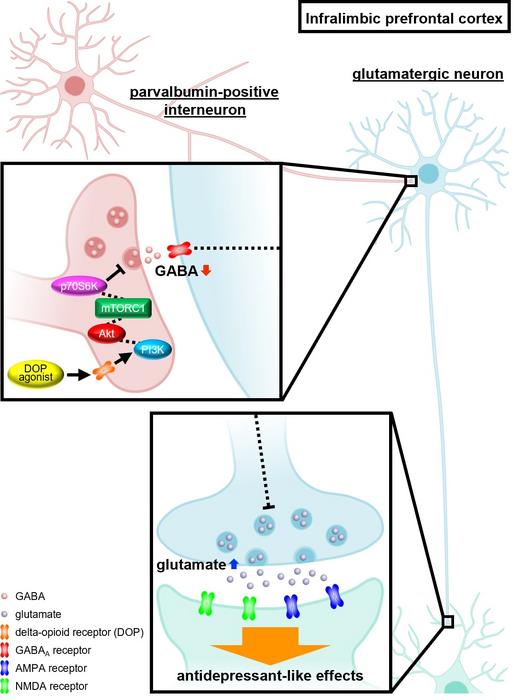Recent groundbreaking research from the Tokyo University of Science has unveiled significant insights into the antidepressant effects of delta opioid receptor (DOP) agonists, particularly as these findings connect to the mTOR-PI3K signaling pathway. This study reveals the potential for DOP agonists to serve as fast-acting antidepressants with fewer side effects than traditional medications currently available on the market. Understanding the underlying mechanisms for these effects could transform the landscape of treatment for anxiety and depression, disorders that have shown alarming global escalation in recent years.
At the forefront of this research is Professor Akiyoshi Saitoh and his collaborator, Mr. Toshinori Yoshioka. They focused their investigations specifically on a substance known as KNT-127, a DOP agonist that has demonstrated preliminary efficacy in animal models exhibiting symptoms akin to depression. While many existing antidepressants require weeks to months before patients experience relief from symptoms, the rapid effects observed with DOP agonists underscore the urgent need for new therapeutic options. This study not only chronicles the behavioral outcomes of KNT-127 administration but also explores the biochemical pathways that facilitate these effects, adding a layer of depth to our understanding of how depression can be addressed at a cellular level.
Initially, the research team conducted a series of behavioral tests on rodents using the forced swimming test (FST)—a paradigm commonly employed to evaluate depression-like behavior in animals. The significance of this methodological choice lies in the FST’s capacity to provoke despair-like symptoms in rodents, paralleling the cognitive and emotional states experienced by individuals with major depressive disorder. The results indicated that a single administration of KNT-127 shortly before the FST markedly reduced the amount of time the test subjects remained immobile. This reduction implies a robust antidepressant-like effect induced by DOP stimulation, highlighting KNT-127’s potential application for human antidepressant treatment.
To further investigate the molecular mechanisms at play, researchers shifted their focus toward the mTOR signaling pathway, which has been previously implicated in conveying rapid antidepressant effects. By administering rapamycin—a known inhibitor of the mTOR pathway—researchers were able to discern the integral role this pathway plays in KNT-127’s efficacy. Remarkably, the inhibition of mTOR reversed the antidepressant-like behaviors induced by KNT-127 during the FST, showcasing that the DOP agonist’s benefits are indeed mediated through mTOR signaling.
In a particularly promising aspect of this research, the targeted injection of KNT-127 into the infralimbic cortex region (IL-PFC) of the mice resulted in observable antidepressant effects through the modulation of the mTOR and PI3K pathways. The IL-PFC area in rodents is functionally analogous to Brodmann Area 25 in humans, a brain region closely associated with mood-related disorders. Intriguingly, it also appears that KNT-127’s efficacy transcends variables such as age, sex, or strain of the animals tested, signifying a broader therapeutic potential among DOP agonists.
Moreover, the study demonstrated that KNT-127 increases glutamatergic transmission in isolated IL-PFC brain tissues by repressing the release of GABA, a neurotransmitter that dampens neuronal excitability. This is particularly noteworthy because it emphasizes how DOP agonists might directly influence mood regulation mechanisms through specific interactions at the cellular level. The research underscored the importance of understanding receptor distribution and function, revealing that DOPs were predominantly expressed in parvalbumin-positive interneurons within the IL-PFC, thereby unmasking cellular expressions that have perhaps been overlooked in previous studies.
Dr. Saitoh, reflecting on the broader implications of this study, indicates that the results provide concrete evidence for the antidepressant efficacy of DOP activation. Profoundly, he emphasizes that DOP agonists could offer valuable treatment alternative options, particularly for patients resistant to conventional antidepressant therapies. This marks a pivotal moment in the ongoing quest for effective mental health treatment methods and aligns with the urgent need for alternatives that act rapidly and with minimal side effects.
As we stand on the precipice of potentially therapeutic advancements, it is crucial to translate these promising findings into clinical applications. If the efficacy found in animal models can be replicated in human subjects, DOP agonists like KNT-127 could fundamentally change how we approach the treatment of depression and anxiety disorders, offering hope to millions burdened by these debilitating conditions.
In summary, the comprehensive exploration conducted by the Tokyo University of Science underlines the promise of DOP agonists as a novel approach to treating mood disorders. As scientists deepen their understanding of the mechanisms of action—wonderfully detailed in this research—a future where fast-acting, safer antidepressants are a reality is closer than ever.
Subject of Research: Animals
Article Title: Delta opioid receptor agonists activate PI3K–mTORC1 signaling in parvalbumin-positive interneurons in mouse infralimbic prefrontal cortex to exert acute antidepressant-like effects
News Publication Date: 6-Dec-2025
Web References: N/A
References: N/A
Image Credits: Prof. Akiyoshi Saitoh, TUS, Japan
Keywords: Antidepressants, Depression, Drug Research, mTOR Pathway, Animal Research, Opioid Receptors, Neuropharmacology, Fast-acting Therapeutics, Anxiety, Psychopharmacology, Clinical Development.





